Before heading to Old Barrack Yard for today’s post, a quick update to last week’s post on Seven St Martin’s Place. Thank you for all the feedback, personal links with the site and thoughts on who could have created the reliefs on the front of the building.
Through Twitter, TheTaoOfOat sent me this link to a site which included some posts from the original sculptor’s daughter. Hubert Dalwood was the sculptor who was commissioned to create the reliefs for the Ionian Bank. The material is aluminium which probably makes them rather unique.
I have been in contact with Hubert’s daughter, Kathy Dalwood, who is also a sculptor, to discover more about the background to these reliefs, and she will be letting me have some more information when she returns from travel. I have also e-mailed the developer to ask whether the reliefs will remain with the new hotel development.
Thanks again for all the feedback, it is brilliant to be able to bring some recognition to these wonderful reliefs and I will update the blog post as I get more information.
Now to the subject of today’s post – Old Barrack Yard.
I was in Knightsbridge last Tuesday on a rather wet July day. Leaving the underground station at Hyde Park Corner, I headed west along Knightsbridge, and a short distance along, turned south into Old Barrack Yard. The part I was interested in was not the street that connects directly onto Knightsbridge (which is a building site at the moment), but a bit further along after where the street turns east, there is a southern branch heading down towards Wilton Row.
I have marked the location in the following map extract (© OpenStreetMap contributors):
My father took a number of photos of Old Barrack Yard on a rather sunny day in 1949:
Seventy years later, I photographed the same scene on a very wet day:
Although the weather conditions are very different, and my use of colour photography also tends to suggest a difference in the two scenes (I often wonder whether I should switch to black & white for these comparison photos) – the scene is very much the same, apart from some minor cosmetic differences.
The paving stones do though appear to be different in the two photos.
The name – Old Barrack Yard – provides a clue as to the history of the area.
The following map extract is from Horwood’s map of London, created between 1792 and 1795. The large block in the centre of the map is Knightsbridge Barracks.
Stabling for the Grenadier Guards were in use here around 1762, and by 1780 barracks had been fitted out, with an entrance through to Knightsbridge, allowing direct access to Hyde Park.
Ornate gardens had been created to the south of the barracks and a large yard was to the right of the barracks – part of this yard and the gardens to the south are the location of Old Barrack Yard today.
The military released the barracks in the 1830s, and the following extract from Reynolds’s 1847 map of London shows how the area had developed:
The barrack block can still be seen, and on the western edge of the original gardens, just below the barracks, is the church of St. Paul’s, built in the early 1840s. The yard can still be seen to the right of the barracks, and a crescent of housing has been built up to the corner of the church – this is Wilton Row.
Note that to the right of the old barracks block is the abbreviation “Exh” – this refers to an exhibition that was established here in the 1840s using parts of the yard and the old barracks.
The Chinese Collection was an exhibition of Chinese artifacts collected by an American merchant, Nathan Dunn, who had spent 12 years in Canton. The exhibition had previously been on display in the United States, but brought to London at the encouragement of a number of learned societies and individuals. Interest in China was high at the time with the first Opium War about to be brought to a successful close with the signing of a peace treaty with the Chinese in Nanking.
The Illustrated London News reported on the Chinese Collection in August 1842:
“Upon the left-hand side of the inclined plan, extending from Hyde Park Corner to Knightsbridge, and towards the extremity of St. George’s-place, a grotesque erection has lately sprung up with all the rapidity which distinguishes the building operations of the present day.
As the work proceeded, many were the guesses at the purpose for which it was intended; and to feed the suspense of the many thousands who daily pass this thoroughfare, the work was covered with canvas until just completed. The structure in question is the entrance to an extensive apartment filled with ‘curiosities of China’. In the design this entrance is characteristically Chinese, and is taken from the model of a summer residence now in the collection. It is of two stories, the veranda roof of the lower one being supported by vermilion-coloured columns, with pure white capitals. and over the doorway is inscribed in Chinese characters ‘Ten Thousand Chinese Things’. Such summer-houses as the above are usual in the gardens of the wealthy in the southern provinces of China, often standing in the midst of a sheet of water, and approached by bridges, and sometimes they have mother-of-pearl windows.
Although the above building is raised from the pathway, whence it is approached by a flight of steps, it is somewhat squatly proportioned. But such is the character of Chinese buildings, so that when the Emperor Kesen-king saw a perspective of a street in Paris or London he observed, ‘that territory must be very small whose inhabitants were obliged to pile their houses to the clouds;’ and, in a poem on London, by a Chinese visitor it is stated – ‘The houses are so lofty that you may pluck the stars’.
The collection we are about cursorily to notice, has been formed by the American gentleman, Mr. Nathan Dunn, who resided in China for a period of twelve years, and experienced more courtesy from the Chinese than generally falls to the lot of foreigners.
The design at first was merely to collect a few rare specimens for a private cabinet; but the appetite grew with what it fed upon, and thus Mr. Dunn has assembled what may, without exaggeration, be termed the Chinese world in miniature; and, it is equally true, that by means of this collection, we may, in some sense, analyse the mental and moral qualities of the Chinese, and gather some knowledge of their idols, their temples, their pagodas, their bridges, their arts, their sciences, their manufactures, their trades , the fancies, their parlours, their drawing rooms, their cloths, their finery, their ornaments, their weapons of war, their vessels, their dwellings, and the thousands of et ceteras.”
The approving description of the Chinese Collection in the Illustrated London News continued for a few more hundreds words. The exhibition was a considerable success, and was the place to be seen in 1842.
A view of the interior of the Chinese Collection:
The Chinese Collection exhibition closed in 1846, and in 1847 the pagoda that had been built for the exhibition at the entrance to Old Barrack Yard was purchased by James Pennethorne and relocated to an island in the lake at Victoria Park, Hackney, where it could be found until 1956.
By 1895 the barrack’s had disappeared (partly demolished in the 1840s, with final demolition in the late 1850s), and the buildings that form the lower part of Old Barrack Yard, photographed by my father, can be seen in the following map extract.
Credit: ‘Reproduced with the permission of the National Library of Scotland’
The upper part of Old Barrack Yard was still there, however this area would be developed in the 20th century, leaving Old Barrack Yard as a street that runs from Knightsbridge, turns to the east, then south into the section focused on in today’s post.
The entrance to Old Barrack Yard from the north is through a building that separates off this southern section of the street. The view from the end of the entrance arch:
The same view in 2019 on a very wet July day (although with the cloud cover, i did not have the contrast problems that my father had on a very sunny day):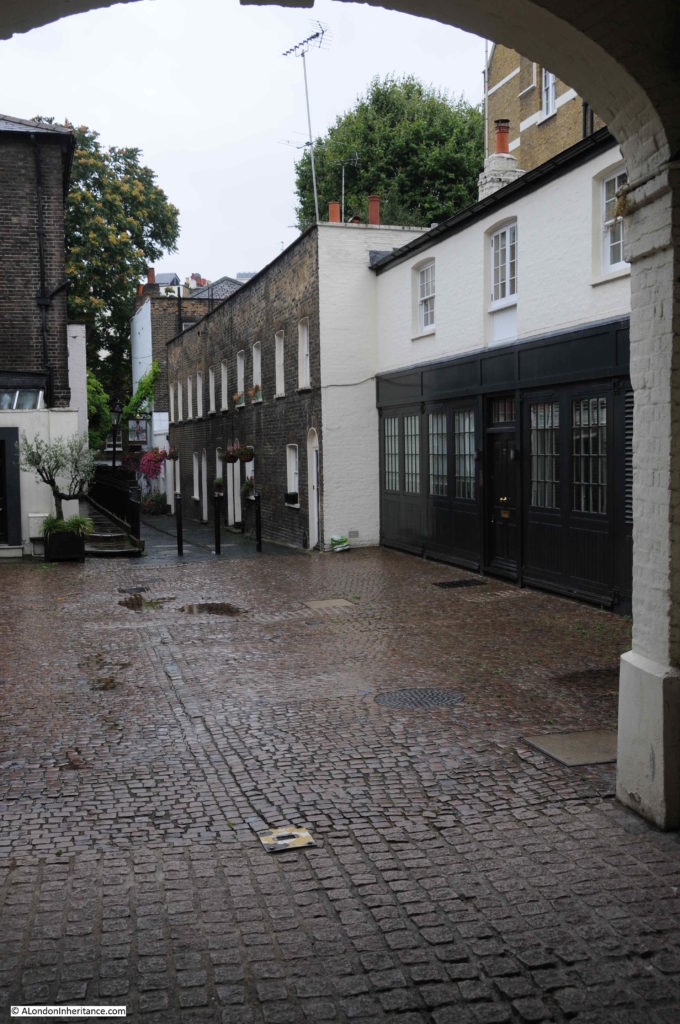
Walking through the arch and this is the view looking back:
The same view today;
There are a number of references, including in the latest Conservation Area Audit by Westminster City Council, that the buildings around the arched entrance, shown in the above photos are part of the original stables for the barracks. My only concern is that they do not appear in the maps prior to 1895, although being stable buildings they may have been considered as part of the yard and therefore not shown as separate structures.
The top section opens out with the potential stable buildings surrounding a wider section of Old Barrack Yard, so this part of the street does have the appearance of a stabling area. The final, southern section is composed of a narrow walkway, separated from the stables area by three bollards, which appeared in the 1949 photos and remain to this day.
Two and three storey, early 19th century buildings line this final section of Old Barrack Yard.
1949 above and 2019 below. the tall buildings directly behind the old stables detract from their appearance, but Old Barrack Yard remains much the same.
A landscape view of the same scene:
I really like small details that remain the same – the leaning lamp-post, the access covers on the ground, the bollards, the drainage channel.
Walking backup, this is a wider view of what could have been part of the original stables for the barracks. The appearance perfectly fits the function of a stables, with a wider space between the buildings than in the rest of the street, with large openings on the ground floor for stables, rather than brickwork.
At the southern end of Old Barrack Yard is the side of the Grenadier pub. There is a doorway at the end Old Barrack Yard which provides access to steps that lead down into Wilton Row.
Looking back up from the southern end of Old Barrack Yard:
Walking through the gate at the end of Old Barrack Yard and down the steps takes us into Wilton Row. This is the view looking back on the Grenadier pub. The gate to Old Barrack Yard is on the right.
Parts of the Grenadier building could date from 1720, when it may have been part of the officers mess for the barracks. Again, my only concern is that the pub is not shown as a separate building on any of the maps prior to 1895.
To try to trace the age of the pub, I have been searching newspapers for any references.
The very first reference dates from 1828, when on the 20th February 1828, the Morning Advertiser carried an advert, with a rather shocking exclusion:
“WANTED a thorough SERVANT for a Public-House. One with a good character may apply at the Grenadier, Knightsbridge Infantry Barracks – No Irish need apply”
That last sentence is still shocking to see in print. The address implies that the pub was part of the infantry barracks, which makes sense as the pre-1895 maps may not have gone into detail with the structures within the barracks and barrack yard.
I have also found a couple of references that for a short period the pub was called the Guardsman. I have been trying to find newspaper references to confirm, and have only found one. In the Morning Advertiser on the 16th October 1856 there is the following advert:
“BRICKS – FOR SALE. 150,000 Bricks, 10,000 Pantiles, 20,000 plain Tiles, at the Life Guardsman public-house, Knightsbridge, and six adjoining houses. Inquire on the Premises.”
I am not aware of any other pub in Knightsbridge with this name, although given the barracks in Knightsbridge, this may be a possibility, however the late 1850s are when the final remains of the old barrack buildings were demolished, so the sale at the pub may have been of the demolished remains of the old barrack block.
What is clear is that the Grenadier is an old pub, and has its origins in the infantry barracks that occupied the area for many years.
The Grenadier in 1951:
Old Barrack Yard is part of the very extensive Grosvenor Estate land, and is also within the Belgravia Conservation Area, this last classification should help Old Barrack Yard, with its references back to the original infantry barracks in Knightsbridge, survive for many more years.
Any signs of the Chinese Collection have long since disappeared. After the exhibition closed, the collection toured the country and then returned to the United States. It did later return to London, when it opened at Albert Gate in 1851, not far from the original location. The Chinese Collection was not as popular this second time round, and closed a year later, with items from the collection then being sold at auction.
Old Barrack Yard is one of those hidden locations where you can walk from a very busy street into a totally different place. Whilst I was there, very few people walked through the street. Most of the people I saw were workers from the neighbouring hotels and offices using the arch at the top of the yard to smoke or make phone calls whilst sheltering from the rain.
It is well worth a visit, with the Grenadier pub an added bonus.

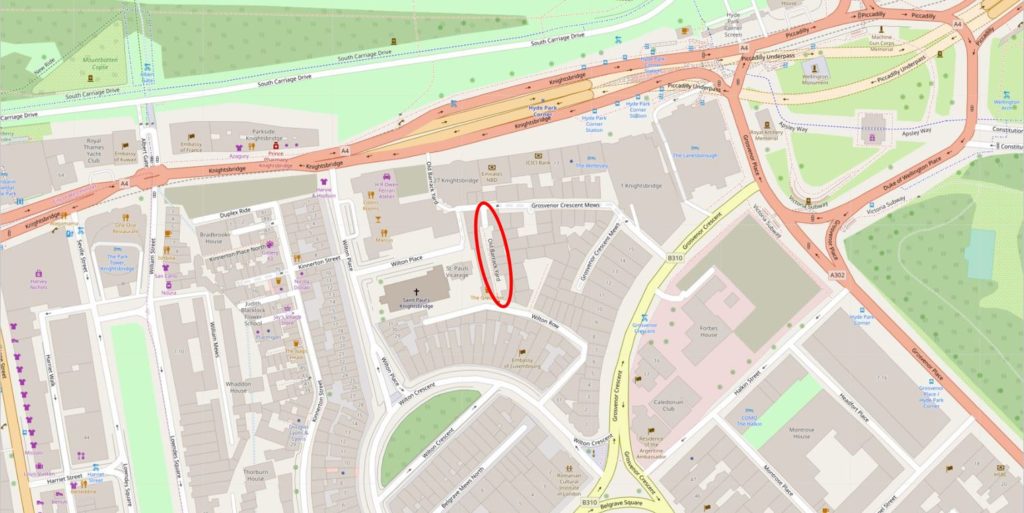




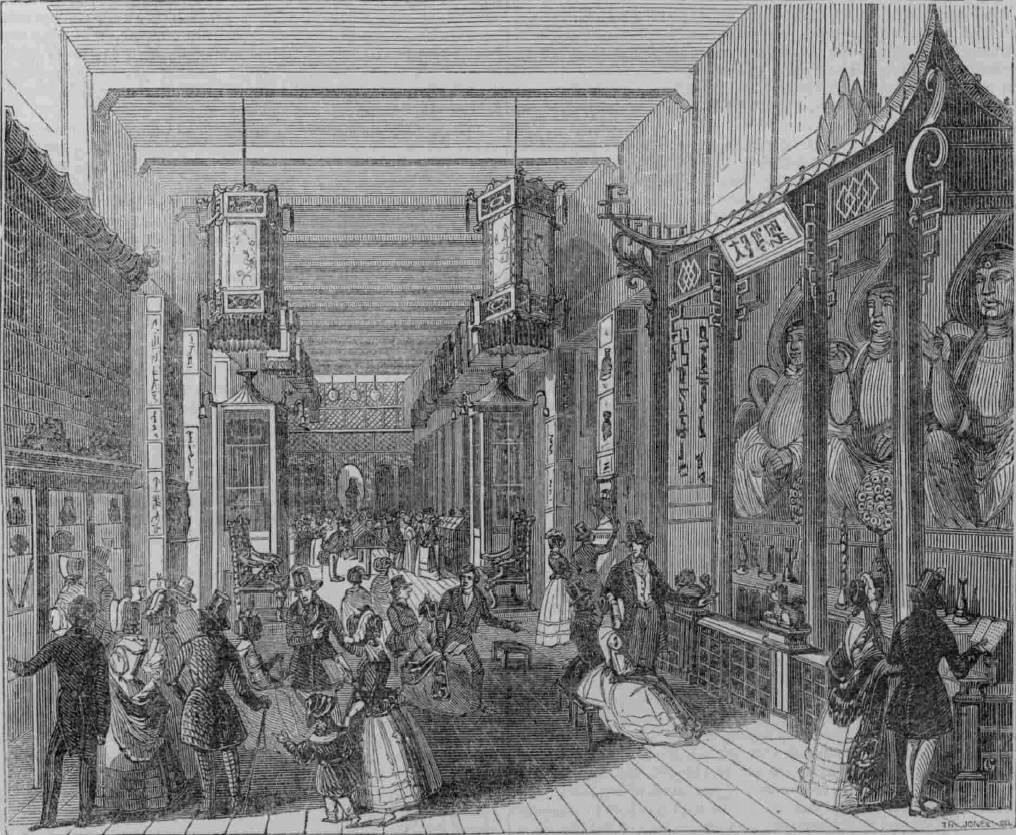

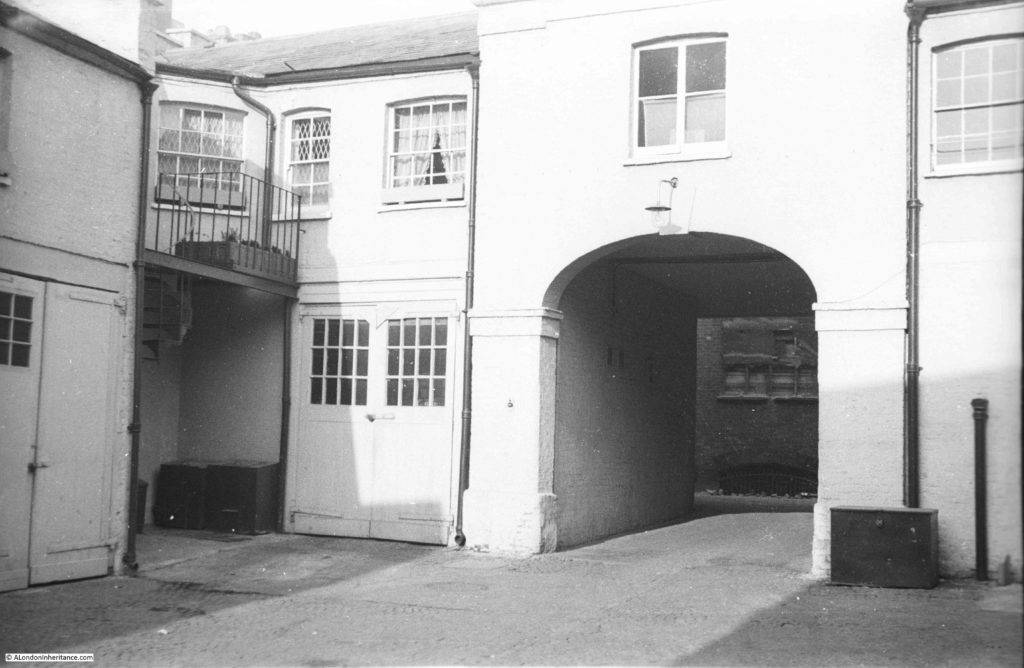

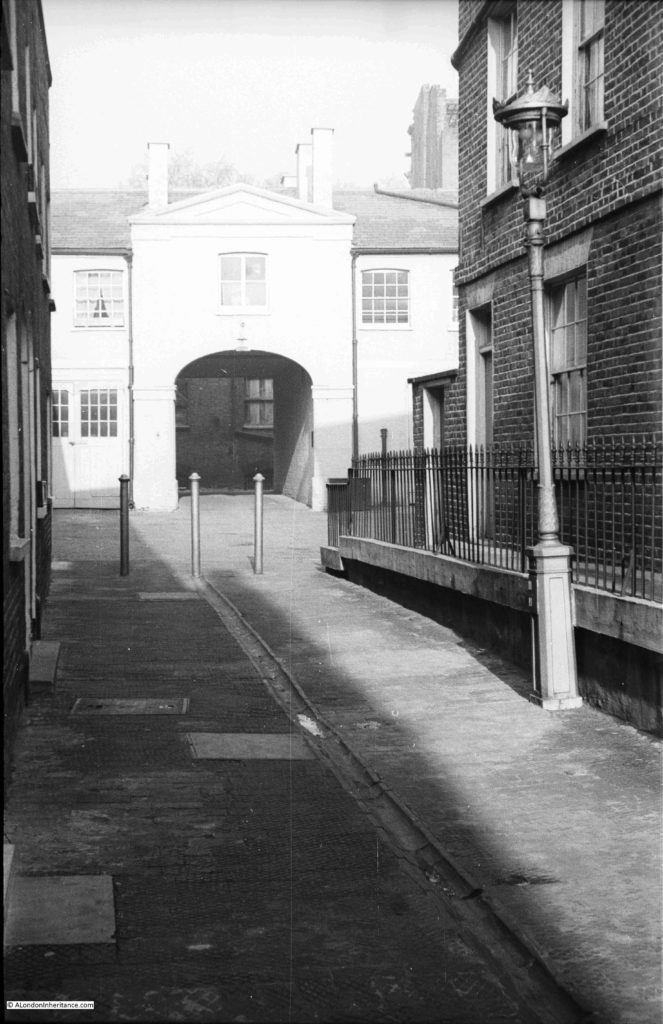

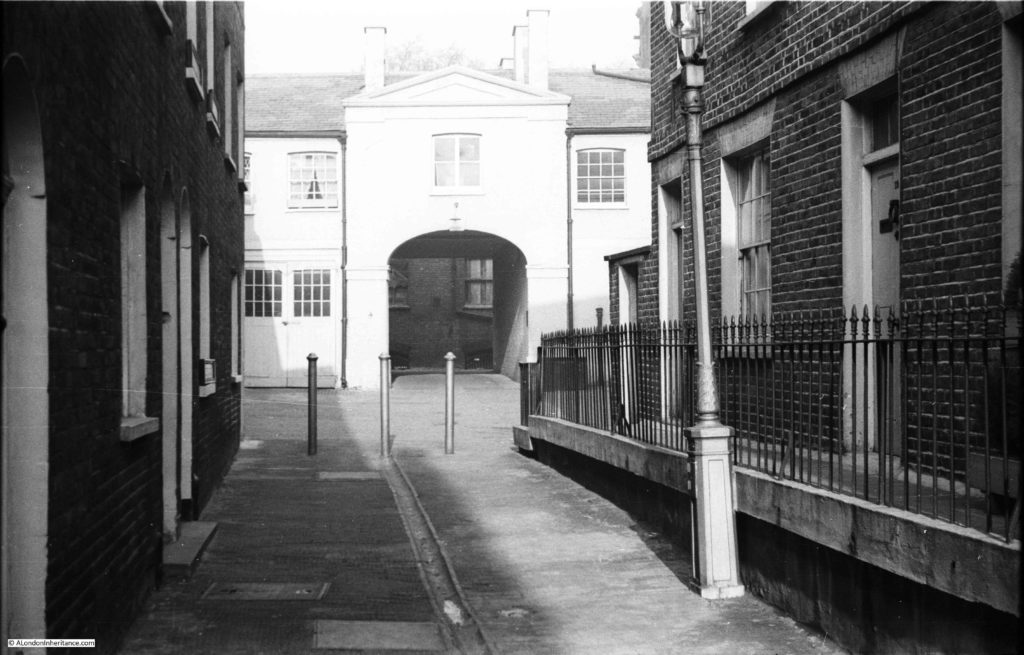
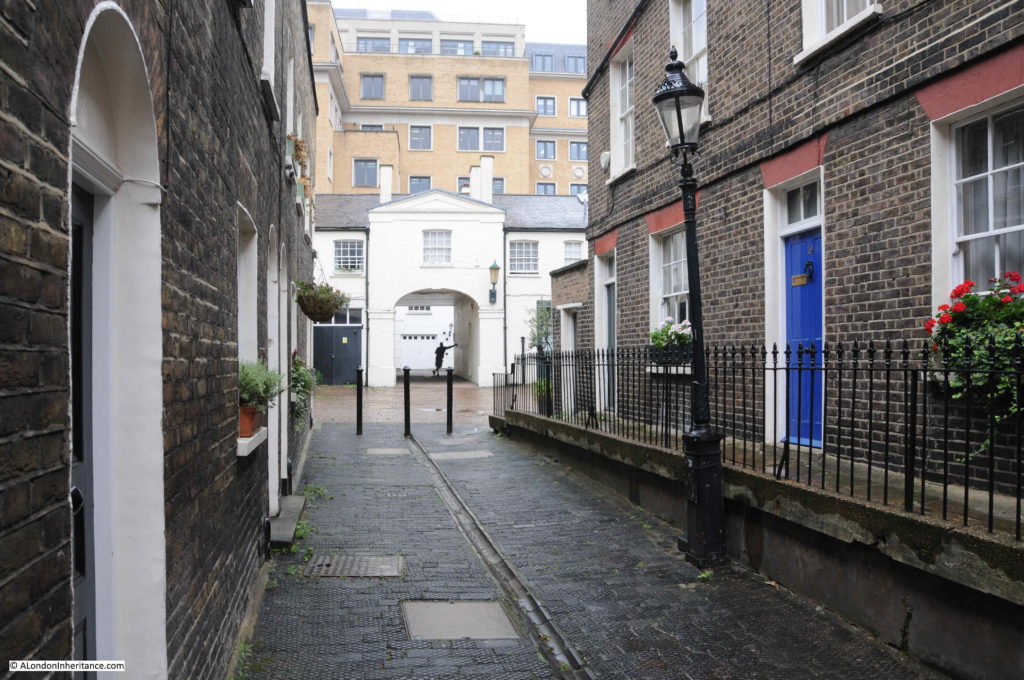





Another great post. Very interesting – I remember drinking in the Grenadier after singing in concerts at St Paul’s, and going even further back, about 25 years ago when I lived in the area. It doesn’t appear to have changed much in my time, yours, or your father’s!
Intriguing follow up work on the relief sculptures too. Look forward to hearing what you unearth there in due course.
Good morning. Delighted the mystery was solved and I look forward to seeing more in the future. Just looking at the maps…I note that Tattersall’s horse market is slightly to the right of the yard and wondered if perhaps they had links, horseflesh being what it is? Would certainly be a place to stick the nags.
That pub looks like a must visit sometime. It only goes to show you can go past places for a long time without realising what is hidden!
The building is marked as a pub on the 1869 OS map
Strangely, Old Barrack Yard is marked as Phillips Terrace on the OS 1916 map, but back to the correct name by 1951
Named after John Phillips – My 4x Great Grandfather who leased Barrack Yard and built the houses in Wilton Place where he and his sons lived…
Another hidden gem. Many thanks.
Thank you so much for this post, David. Being able to visit The Grenadier (one of my favourite hideaway pubs) on a Sunday morning is such a treat. And the Then/Now photographs are wonderfully evocative of that inter-connecting little network of mewses. Just delightful!
Very evocative photos -must visit the Grenadier one of many.
Also the archway and yard were used in the last scene of the classic film “Scrooge” – wonderful that it has survived so well!
This film of London from the 1920s includes shots of Old Barracks Yard (starting at 00:55) and displays the Street sign as Phillips Terrace SW.
Hello, do you have a link to this film please? I’d be very interested as my 4x Great Grandfather leased the barracks in the 1830’s and the terrace was probably named after him. thank you